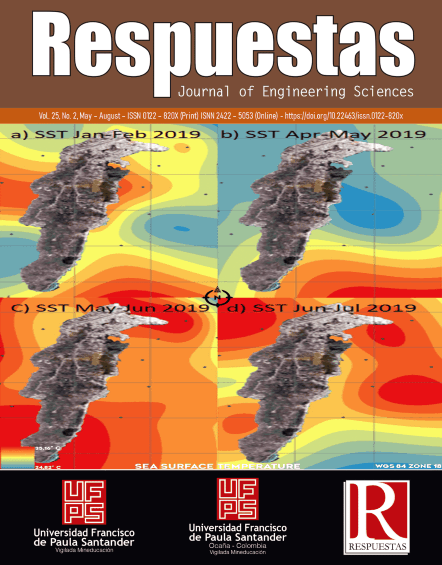Behavior in the electric current curve by changing the anodizing area
Comportamiento en la curva de la corriente eléctrica cambiando el área de anodizado
Main Article Content
In this work, we studied the change in the electric current and the length of the nanotubes depending on the area and the exposure time in the anodizing process. Over time the anodizing area was changed with a rate of 0.5 cm2 to 2.5 cm2 using a total anodizing time of 60 min, using a chemical solution (2ml /3 ml /0.30g ) and maintaining a constant anodizing voltage equal to 20 V. The behavior in the nanostructures was recorded by the evolution of the current density as a function of the anodizing time. The morphology of the nanostructures was analyzed by means of scanning electron microscopy (SEM). With the use of the Imagej program. The size, length and diameter of the titanium nanostructures are obtained. The sample that presented the best behavior was that of an anodizing area of 1.5 cm2 and an anodizing time of 36 min. This presents a surface where open nanotubes are observed in the upper part with a vertical length of 0.23 μm and a pattern thereof organized in a circular arrangement with a diameter of 0.035 μm. It was observed that increasing the area under these anodizing conditions decreased the length of the nanotubes. The mobility of the loads was always greater with the area of exposure, which is observed in the increase of the current
Downloads
Article Details
Z. W. Pan, Z. R. Dai, Z. L. Wang, “Nanobelts of Semiconducting Oxides”. Science, vol. 291, pp. 1947-1949, 2001. doi10.1126/science.1058120.
J.M. Macak, P. Schmuki, “Anodic Growth of Self-Organized Anodic TiO2 Nanotubes in Viscous Electrolytes”. Electrochimica Acta, Vol.52,pp.1258-1264,2006. doi:10.1016/j.electacta.2006.07.021 .
Z. W. Pan, Z. R. Dai, Z. L. Wang, “Lead oxide nanobelts and phase transformation induced by electron beam irradiation”. Appl Phys Lett., vol. 80, pp. 309,2002. doi:10.1063/1.1432749 .
C. Li, G. Fang, S. Xu, D. Zhao, X. Zhao, “Phase-segregation assisted growth of quasi-aligned ZnO nanorods on a Mg0.6Zn0.4O-coated Si substrate by thermal evaporation”. Nanotechnology, vol. 17, no 21, 2006. doi:10.1088/0957-4484/17/21/014 .
Gorun Butail, P.G. Ganesan, M. Raddiar, R. Teki, N. Ravishankar, D.J. Duquette, Ganpati Ramanath, “Kinetics of titania nanotube formation by anodization of titanium films ”. Thin Solid Films, vol. 519, pp. 1821–1824, 2011. doi:10.1016/j.tsf.2010.10.004 .
Y.R. Ma, C.C. Tsai, S.F. Lee, K.W. Chen, Y. Liou,Y.D. Yao, “Magnetic properties of large-area one-dimensional WO2 and MoO2 nanorods”. J. Magn. Magn. Mater, vol. 304, pp. e13-e15, 2006. doi:10.1016/j.jmmm.2006.02.025 .
R.S. Devan, W.D. Ho, J.H. Lin, S.Y. W, Y.R. Ma, P.C. Lee, Y. Liou, “X-ray Diffraction Study of a Large-Scale and High-Density Array of One-Dimensional Crystalline Tantalum Pentoxide Nanorods”. Crystal Growth & Design, vol. 8 no. 12, pp. 4465-4468, 2008. doi:10.1021/cg800369s.
K. Nagashima, T. Yanagida, H. Tanaka, T. Kawai, “Interface effect on metal-insulator transition of strained vanadium dioxide ultrathin films”. J. Appl. Phys., vol. 101, 2007. doi:10.1063/1.2424321.
Y.R. Ma, C.M. Lin , C.L. Yeh , R.T. Huang, “Synthesis and characterization of one-dimensional WO2 nanorods”. Vac. Sci. Technol. B., vol. 23, 2005. https://doi.org/10.1116/1.2050668.
L. Young, Anodic Oxide Films, Academic Press London und New York, 1961.
D. A. Vermilyea, “Anodic Films in Advances in Electrochemistry and Electrochemical Engineering”. Interscience, vol. 3, pp. 248, 1963.
C.J. Brinker, G.W. Scherer, “The physics and Chemistry of Sol-Gel Processing”. Academic Press Sol-Gel Science, 1990.
L.L. Hench, J.K. West, “The sol-gel process”. Chem. Rev, vol. 90, pp. 33-72, 1990.
M.M.Lohrengel, “Thin anodic oxide layers on aluminium and other valve metals: high field regime”. Materials Science and Engineering: R: Reports, vol.11, pp. 243-294, 1986. doi:10.1016/0927-796x(93)90005-n
E.J.W. Verwey, “Electrolytic conduction of a solid insulator at high fields The formation of the anodic oxide film on aluminium”. Physc, vol. 2 no. 1-12, pp. 1059-1063, 1935. doi:10.1016/s0031-8914(35)90193-8
F Redondo Quintela, Roberto C. Redondo Melchor -, Electrostática y Corriente Eléctrica para Ingenieros, STS EDICIONES,,232 ,2019.
H. M. Mateus , J. Bautista-Ruiz , J.Barba-Ortega and M. R.Joya,” Formation of Titanium oxide nanotube arrays by controlling H2O and time through anodic oxidation” Rasyan. J. Chem.12, |1304 – 1314,2019. http://dx.doi.org/10.31788/RJC.2019.1235265.
K.J. Vetter, “Electrochemical Kinetics: Theoretical Aspects”. Springer-Verlag, 1967.
D.D. DeFord, “Electroanalysis and Coulometric Analysis”. Anal. Chem., vol. 30, pp. 613-619, 1960. https://doi.org/10.1021/ac60161a604.
C. Vanleugenhage, J. Van Muylder, N. De Zoubov, M. Pourbaix, J. Besson, W. Kunz, K. Schwabe, “Contribution a l'etablissement d'un atlas d'equilibres electrochimiques”. Electrochim. Acta, vol. 1, pp. 349-353, 1959. doi:10.1016/0022-0728(60)85048-6 .
C.G. Zoski, “Handbook of Electrochemistry”. Elsevier, 2007.
J.W. Schultze, “Stability, reactivity and breakdown of passive films. Problems of recent and future research”. 5.1. Electrochimica Acta, vol 45, pp. 2499-2513, 2000. doi:10.1016/s0013-4686(00)00347-9 .
P. Schmuki, “From Bacon to barriers: a review on the passivity of metals and alloys”. J. Solid State Electrochem, vol 6, pp. 145-164, 2002. doi:10.1007/s100080100219 .
E. Horwood, “Instrumental Methods in Electrochemistry”, Halsted Press, 1985.
J. Tafel, Z. “Über die Polarisation bei kathodischer Wasserstoffentwicklung ”. Physik. Chem, vol. 50, pp. 641, 1905. doi:10.1515/zpch-1905-5043
H. Masuda, K. Fukuda, “Ordered Metal Nanohole Arrays Made by a Two-Step Replication of Honeycomb Structures of Anodic Alumina ”. Science, vol. 268, pp. 1466-1468, 1995. doi:10.1126/science.268.5216.1466.
N. Khalil, J.S. Leach, “The anodic oxidation of valve metals—I. Determination of ionic transport numbers by α-spectrometry”. Electrochim. Acta, vol.31, pp. 1279-1285, 1986. doi:10.1016/0013-4686(86)80148-7 .
K. Yasuda, J.M. Macak, S. Berger, A. Ghicov, P. Schmuki, J. “Mechanistic Aspects of the Self-Organization Process for Oxide Nanotube Formation on Valve Metals”. J Electrochem Soc, vol.154, pp.C472. 2007. doi:10.1149/1.2749091 .
Zhang, K., Cao, S., Li, C., Qi, J., Jiang, L., Zhang, J., Zhu, X. Rapid growth of TiO2 nanotubes under the compact oxide layer: Evidence against the digging manner of dissolution reaction. Electrochemistry Communications, 103, 2019. doi:10.1016/j.elecom.2019.05.015
P. A. Marques, K. F. Albertin, G. Z. Monteiro, I. Pereyra,Optimized synthesis for improved TiO2 NT array surface, Cerâmica vol.65 ,pag.327-334,2019. doi:10.1590/0366-69132019653752583




 Perfil Google Scholar
Perfil Google Scholar



